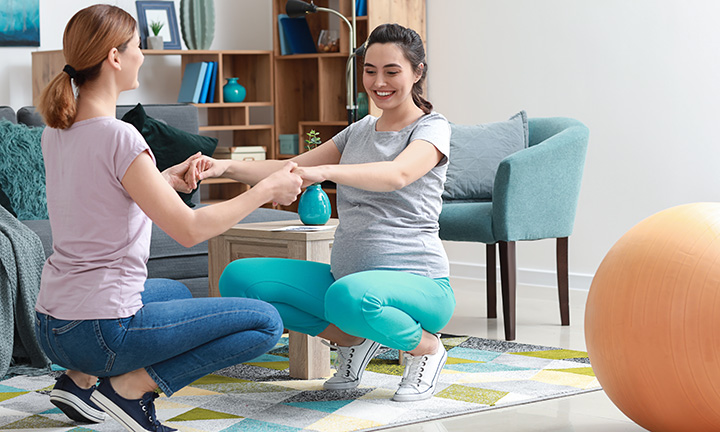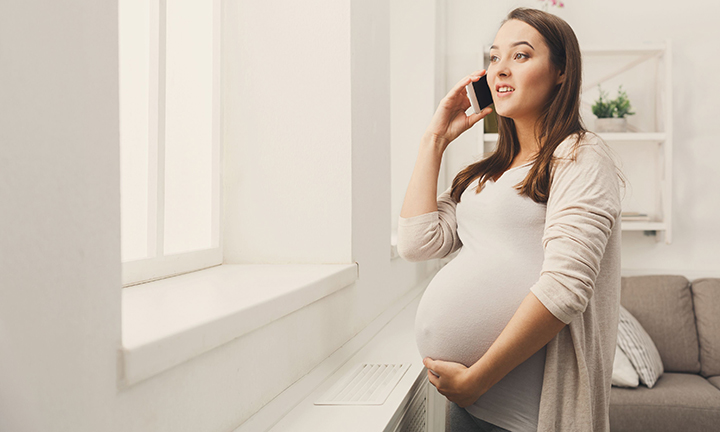
FAQ: Vaginal Birth
Key Takeaways
Labour and delivery are experiences that inspire lots of questions from pregnant people, who might feel both nervous and excited about what lies ahead. As an expectant parent, you'll want to know as much as possible about childbirth ahead of time, even though you can’t predict exactly what will happen in your own situation. Reviewing these frequently asked questions about vaginal birth may help you feel a little more prepared for the vaginal delivery of your baby.
How Long Does a Vaginal Birth Take?
Every birth is different, and factors like the size and position of the baby and the progress of cervical dilation can all affect the time it takes for the baby to be born through vaginal delivery.
For first-time parents, the first stage of labour (from the onset of labour until you’re fully dilated) may take anywhere from 8 to 18 hours, and perhaps longer. Once you’re fully dilated, the pushing stage may take up to 3 hours. For parents who have given birth before, the first stage of labour can sometimes be shorter, around 5 to 12 hours, and the pushing stage is generally no longer than 2 hours; however, each birth is different. Some babies are born in several hours; others might take longer.
What Are the Stages of Labour for Vaginal Birth?
If everything goes as expected, you can expect labour to start between weeks 38 and 42 of the third trimester. There are several signs of labour to be aware of, and once labour starts, you will likely experience three stages if you’re having a vaginal birth.
Stage 1. Preparing for vaginal delivery
This first stage of labour ranges from a few hours to 12 to 18 hours on average, depending on whether this is your first pregnancy or not, and is known as established labour. This is when your cervix opens from 4 to 10 cm and your contractions become stronger and more regular. Before the first stage of labour begins, there is usually the latent phase.
Stage 2. Birth of the Baby via Vaginal Delivery
As you reach 10 cm dilation, you enter the second stage of labour, and can begin pushing in time with your contractions to help your baby move through the birth canal for a vaginal delivery. This stage can last less than an hour, especially if you’ve had a vaginal birth in the past, but it may last as long as two or three hours, particularly if it’s your first baby. Once the baby is born, the umbilical cord will be cut, and your baby will be handed to you to hold and cuddle. Then the staff will take your baby to check on their health.
Stage 3. Delivery of the Placenta
After the birth, you might think you’re all done, but you still have the vaginal delivery of the placenta. You can choose active or physiological management to deliver the placenta. You might experience some contractions as you gently push the placenta out, but these will be milder than those you felt during labour.
When Does Labour Need to Be Induced?
Sometimes labour needs to be induced. This can happen if you haven’t gone into labour naturally by week 41 or 42, if there are complications that affect your health or that of your baby, or if you experience premature rupture of membranes (your water breaks too early). Your physicians might help your cervix dilate and rupture your membranes, which can promote the start of labour, or you might be given a medication that is similar to the labour-inducing hormone oxytocin.
What Are My Pain Relief Options During Vaginal Birth?
There are many options to help manage your pain during vaginal birth and labour, from massage to medication, which you might want to consider if the pain becomes too intense. Discuss the options with your medical team beforehand so that you know what to ask for during labour and birth.
For pregnant people who opt for medication to remain comfortable during a vaginal delivery, one favoured method of pain relief is an epidural, pain medications are administered through a small tube placed in the lower back, which numb the sensation in the lower half of the body to minimise pain during labour and vaginal birth. You'll remain awake and alert during labour and should be able to ‘push’ when it's time to deliver your baby. There are some potential side effects, and you'll want to discuss these with your doctor or midwife before you decide to go with an epidural or any other pain relief option.
Read more about vaginal birth and labour pain relief to better understand the options available to you.
Do I Need a Birth Plan, and What Should It Include?
It’s completely up to you whether you choose to have a birth plan or not. Some pregnant people prepare a birth plan, which is then shared with their medical team in advance. Your midwife can also help you create your birth plan. Birthing plans list preferences regarding pain relief, support person(s), any desire to move and change positions during labour, requests relating to food and fluids, and information about preferred comfort measures, such as music.
Ensure you converse with your doctor or midwife about your birth plan well in advance of labour, and have printed versions with your medical team, as well as several extras in your hospital bag, just in case.
Keep in mind that it’s hard to know how your labour will turn out, and that you'll need to be flexible. Stay open to unexpected developments, and go with the flow of how you’re actually feeling during labour.
Will I Need Vaginal Stitches After Birth?
You may need vaginal stitches after birth if you experience vaginal tearing during birth. Even a little tear of the skin around the entrance to the vagina might require some stitches, while a more severe tear will definitely require stitches. Vaginal tears are more common for a first birth, and also during a quicker birth where the vaginal tissue has had less time to stretch.
What Is the Recovery After a Vaginal Birth Like?
You might be wondering ‘How long does it take to recover from vaginal birth’? but there’s no one-size-fits-all answer or time frame. Vaginal birth recovery is usually quicker and less uncomfortable than it is for Caesarean birth recovery, with a shorter hospital stay.
If you have sustained a more significant tear, you might endure discomfort for a number of weeks. Nevertheless, following any vaginal delivery, you will experience some vaginal pain or discomfort after giving birth, particularly when sitting or using the restroom.
After a vaginal birth you might experience swelling, bruising and soreness around the tear, if you have one, and general discomfort in your vaginal area. It will help with healing after childbirth to use cold packs in the area, take warm baths and take painkillers if needed. The swelling and bruising will go down with time.
Many people find that the first few bowel movements after vaginal birth can really hurt. To help with constipation or painful gas, you can take short walks, drink lots of fluids and eat foods that are high in fibre. Kegel exercises can help tighten the pelvic muscles, and this will help with incontinence and restoring rectal function.
How long you bleed after vaginal birth varies, but many people experience some bleeding for several weeks. Bleeding is usually heavier to begin with or when you breastfeed, but gradually decreases and turns brown or pinkish over the weeks until it stops. Plan ahead by having plenty of high-absorbency sanitary pads ready. If you experience bleeding that's heavier than a normal menstrual period, or if the amount of bleeding increases, contact your doctor.
What Happens Once Your Baby Is Born?
Once your baby is born, your midwife will review your newborn's health before they are placed on your chest for skin-to-skin cuddles. While you are locking eyes with your baby and absorbing their smell, your placenta will be delivered, and any tearing or episiotomy that you may have had during vaginal delivery will be repaired. An episiotomy is an incision your doctor may make in the area between your vagina and anus (called the perineum) to help deliver your baby and to avoid extensive tearing.
Can I Breastfeed Right After a Vaginal Birth?
Yes, you'll want to start breastfeeding as soon as possible after birth, so your baby can start practicing latching on and sucking. Your baby's first food will be a nutritious liquid called colostrum, which is what your breasts produce prior to breast milk. Colostrum lasts for a few days after labour, and is a yellower, thicker substance than breast milk, which comes in after a few days.
Are There Risks of Vaginal Birth Complications?
Yes, there are risks of vaginal birth, such as vaginal tearing and pelvic floor muscles weakening. The tearing can be stitched up by your doctor, and Kegel exercises can help tighten those muscles.
Some complications that arise mid-vaginal delivery may result in an emergency caesarean being recommended to ensure the mum and baby’s health. Some potential risks of vaginal birth can be avoided by scheduling a caesarean in advance.
Can I Have a Vaginal Birth After a Caesarean Section?
You may be able to have a vaginal birth after caesarean section (a VBAC) if you are otherwise a ‘good candidate’ for a vaginal delivery, and if your earlier caesarean wasn’t such that it would make a vaginal birth more dangerous. Let your doctor or midwife know early in your pregnancy if you are interested in having a VBAC, so you can become informed about the benefits and risks of vaginal birth that would apply to your situation.
Can I Have a Vaginal Birth for Twins?
Yes! Many people who are pregnant with twins have a vaginal birth. However, if one or both of your babies are breech, then a c-section may be advised. Generally, a vaginal triplet birth is rarer, as it is for higher order multiples, because the risks are greater.
Can I Have My Partner With Me During Vaginal Delivery?
It’s important to have a good support person during vaginal delivery to help you with breathing and relaxation techniques, timing your contractions, and even being there just to hold your hand. This, of course, doesn’t have to be your partner. Many pregnant people ask a close relative or friend. Some choose to hire a doula, a trained labour support professional.
Also, your partner doesn’t have to stay with you the whole time. Many partners choose to take some breaks, or step out during the final stage of delivery. It all depends on a very personal decision regarding what you and your support person are comfortable with.
The Bottom Line
Remember, people have been giving birth vaginally for thousands of years, so trust the medical professionals around you, and don’t forget that the female body is built to do extraordinary things.
As you plan for the birth of your baby, you might be packing your hospital bag or at least deciding what to put in it. One thing you may need is nappies. If you're stocking up on nappies now, download the Pampers Rewards app to get rewards on all those purchases.
How We Wrote This Article The information in this article is based on expert advice found in trusted medical and government sources, such as the National Health Service (NHS). You can find a full list of sources used for this article below. The content on this page should not replace professional medical advice. Always consult medical professionals for full diagnosis and treatment.
Read more about Pregnancy
Related Articles
Join Pampers Club and get:














